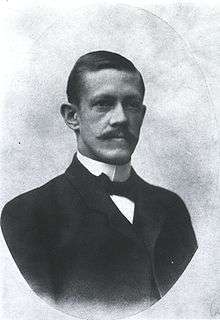Allvar Gullstrand
Allvar Gullstrand (5 June 1862 – 28 July 1930) was a Swedish ophthalmologist and optician.
Allvar Gullstrand | |
|---|---|
 | |
| Born | 5 June 1862 |
| Died | 28 July 1930 (aged 68) |
| Nationality | Sweden |
| Awards | Björkénska priset (1906) Nobel Prize in Physiology or Medicine (1911) |
| Scientific career | |
| Fields | Ophthalmology |
| Institutions | University of Uppsala |
Life
Born at Landskrona, Sweden, Gullstrand was professor (1894–1927) successively of eye therapy and of optics at the University of Uppsala. He applied the methods of physical mathematics to the study of optical images and of the refraction of light in the eye. For this work, he received the Nobel Prize in Physiology or Medicine in 1911.
Gullstrand is noted also for his research on astigmatism[1] and for improving the ophthalmoscope and corrective lenses for use after removal of a cataract from the eye.
He was elected a member of the Royal Swedish Academy of Sciences in 1905, and served on the Academy's Prize Committee for Physics. While serving on the committee, he used his position to block Albert Einstein from receiving a Nobel Prize in Physics for his theory of relativity, which Allvar believed to be wrong.[2]
Gullstrand married Signe Breitholtz (1862–1946) in 1885.
Due to the mathematical content of Gullstand's writing, Horatio Burt Williams lamented in 1926 that "there are few ophthalmologists and not many physiologists who are able to read [Gullstrand's papers] and for the same reason that the chemists of Gibbs' day were unable to read his work."[3]
Gullstrand died in Stockholm in 1930, where he was interred at Norra begravningsplatsen.
Works
- 1904: "Zur Kenntnis der Kreispunkte", Acta Mathematica 29:59–100.
- 1906: "Vie réelle optische Abbildung", Kungl. Svenska Vetenskapsakademiens Handlingar 41
- 1908: "Die optische Abbildung im heterogenen Medien und die Dioptrik der Kristal-linse des Menschen", Kungl. Svenska Vetenskapsakademiens Handlingar 43
- 1905: "Über Astigmatismus, Koma und Aberration", Annalen der Physik,(4), 18: 941-973
- 1907: "Tatsachen und Fiktionen in der Lehre von der optischen Abbildung", Archiv für Optik, vol.1 p. 2;
- 1911: Speech at the Nobel Banquet in Stockholm, December 10, 1911
- 1919: "Preparation of non spherical surfaces for optical instruments", Kgl. Svenska Vetenskapsakademiens Handlingar, vol. 60: 155, abstracted in Zeitschrift für Instrumentenkunde, vol. 41 (1921), pp. 123–25
References
- Gullstrand, Allvar (1890) Skand. Arch. f. Physiol.; and (1901) Arch. f. Ophth., 53, pp. 2, 185.
- Ravin, James G. (1999). "Gullstrand, Einstein, and the Nobel Prize". Arch Ophthalmol. 117 (5): 670–672. doi:10.1001/archopht.117.5.670.
- Horatio Burt Williams (1927) Mathematics and the Biological Sciences, Bulletin of the American Mathematical Society 33(3): 273–94 via Project Euclid, quote from page 278
- Allvar Gullstrand on Nobelprize.org including the Nobel Lecture December 11, 1911 How I Found the Mechanism of Intracapsular Accommodation
- Maximilian Herzberger (1960) "Allvar Gullstrand", Journal of Modern Optics 7:237–41.
- Ian R. Porteous (2001) Geometric Differentiation, pp 201,205,271,285, Cambridge University Press ISBN 0-521-00264-8 .
- Frank Tsai (2009) Who was Allvar Gullstrand from Pearls in Ophthalmology.
